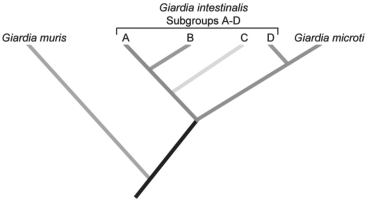
Figure 29.1
Use the following information to answer the corresponding question(s) .
Giardia intestinalis can cause disease in several different mammalian species,including humans.Giardia organisms (G.intestinalis) that infect humans are similar morphologically to those that infect other mammals;thus they have been considered a single species,though other species in the Giardia genus infect other organisms.However,G.intestinalis has been divided into different subgroups based on their host and a few other characteristics.
In 1999,a DNA sequence comparison study tested the hypothesis that these subgroups actually constitute different species.The following phylogenetic tree was constructed from the sequence comparison of rRNA from several subgroups of G.intestinalis and a few other morphologically distinct species of Giardia.The researchers concluded that the subgroups of Giardia are sufficiently different from one another genetically that they could be considered different species.

-According to the phylogenetic tree in Figure 29.1,Giardia intestinalis constitutes a _____ group.
A) paraphyletic
B) monophyletic
C) polyphyletic
Correct Answer:
Verified
Q15: A particular species of protist lacks the
Q16: Figure 29.2 Q17: In an area with a high abundance Q18: Which of the following characteristics is true Q19: According to the endosymbiotic theory,why was it Q21: What is necessary in order for symbiosis Q22: One of the fish in your aquarium Q23: The manufacture of which of the following Q24: Which of the following groups is matched Q25: Assume that some members of an aquatic
![]()
Unlock this Answer For Free Now!
View this answer and more for free by performing one of the following actions

Scan the QR code to install the App and get 2 free unlocks

Unlock quizzes for free by uploading documents